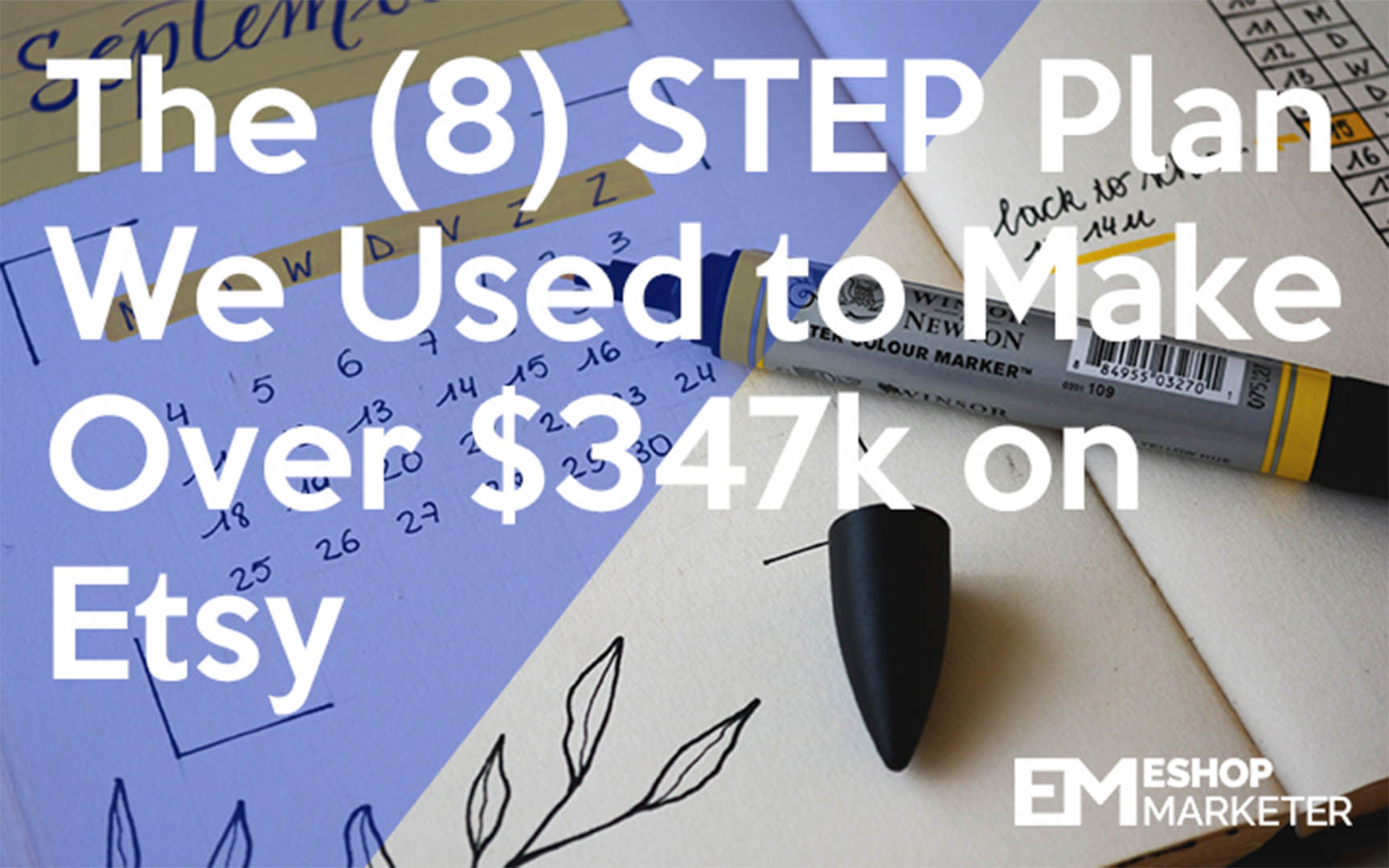We started our Etsy shop Wall Decal Source back in 2012. Since that time we’ve made over 5,400 sales on our main Etsy shop and have grown to be one of the top 100 sellers in our category.
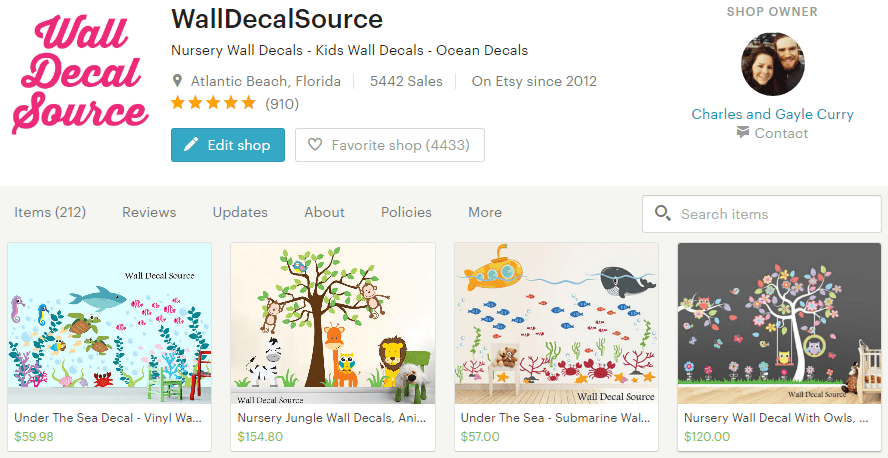
Running our Etsy shop has been surprisingly fulfilling. We’ve served thousands of customers, created hundreds of unique custom items and received almost 900 five-star reviews. It feels great to get pictures from our beloved customers like the one below, knowing that your product is loved and appreciated by someone makes it even more fun to be an Etsy seller.
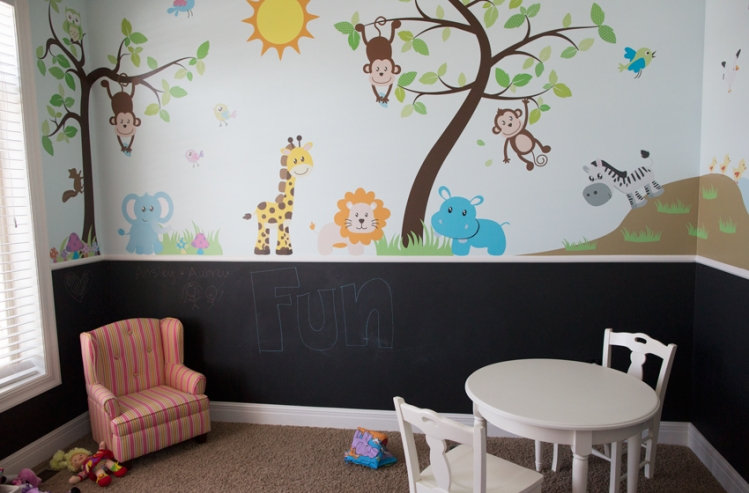
Along the way we have learned a LOT. We’ve made a ton of mistakes and yet somehow still managed to make over $347,658 through our Etsy shop. If you want to start your own business, Etsy is a great place to get launched. We’ve had consistent revenue for years and we’re really glad Etsy is where we started.
Whether you want to sell jewelry, crochet garments, knitted socks, pottery, art, t-shirts, soap or anything else, this guide will show you what steps to take so that you can achieve success. Here’s our 8-step plan to building your own 6 figure Etsy business.
#1 Decide what you want to sell on Etsy.
If you already know what you want to sell on Etsy then good for you! You can skip this step and go straight to step 2. BUT if you’re like most people that want to start selling on Etsy, you probably aren’t sure what you want to sell yet.
First off you should pick something that interests you, if it’s not interesting and exciting to you then what’s the point? If you already have an established skill then you would be better off starting a shop that you can use that skill, versus something you’re totally unfamiliar with. If you have years of experience crocheting baby blankets then you would be much better off selling crocheted blankets instead of handmade pottery.
Consider the startup costs for your niche. If you want to sell pottery then you’ll have to buy some expensive equipment to get started. This is another reason it’s great to start with something you’re familiar with, you probably will already have most of the materials and tools that you need to get started!
If you don’t have experience in anything that go back to square one, what sounds interesting to you? The options are literally endless. Just check out the Etsy categories page and pick something that catches your eye. https://www.etsy.com/categories
If you’re still unsure then here are a few niches that I think have a relatively low startup cost, lots of market opportunity, plenty of profit margin, and are all-around fun.
- Soap
- T-Shirts
- Jewelry of all sorts
- Decals and stickers (we should know
)
- Key chains
- Crocheted items
- Skin care products – Lotions, salves and balms
- Candles
- Food (yes people sell a lot of food on Etsy!)
- Pet collars and leashes
- Pillows and pillow covers
#2 Lay out your goals and vision for your shop.
Now that you know what you want to sell, you need to decide what your goal is.
Do you want to have an Etsy shop that is mostly just for fun that makes a little money on the side?
Do you want to grow it into a business with multiple team members?
Do you want a lean machine that you are the sole owner-operator of and is your main source of income?
This doesn’t need to be over complicated, but it should certainly be considered. The direction and end goal is very important, decide what path you want to take and write it down.
You can even write down an income goal and date you want to achieve it by. It’s also good to write down milestone goals that you want to hit along the way.
Remember you can always change your mind later if you get more or less results, so don’t worry about this part too much.
#3 Do some keyword research.
This is one of the most important parts of building a successful Etsy shop and a lot of people skip this area or just get it wrong.
Etsy is a shopping site but it’s also a search engine, therefore you have to pick out good keywords for your shop sections and listings.
So let’s say that you are starting a shop that sells crocheted items.
There are lots of products you could sell; hats, scarves, blankets, headbands, gloves etc.
It’s usually better to start with a small selection of products to and then to expand once you had success. For example if you sold jewelry you could sell earrings, bracelets, rings, necklaces, anklets, cuffs, and even tiaras, but you could also have a shop completely devoted to just earrings.
I’d suggest starting with a few products and then expanding your product line later.
Back to the crochet shop, let’s say this shop owner decides to focus on hats, blankets and scarves.
You want to end up with at least 5 major keywords that will be used for your shop sections and then 5-10 sub keywords for each of those.
Major keyword example:
- Crochet baby hat
Sub keyword examples:
- Crochet baby hats
- Baby crochet hats
- Crochet baby beanie
- Baby girl crochet hats
- Baby boy crochet hats
Here are the two tools I use to find keywords, the Google Keyword Planner and Etsy search.
This is the process I use to find good keywords
Step 1: Pick an item to build the keywords for. I am going to use this item for an example.
Step 2: List out the first 2-3 keywords you can think of for the item.
- Mens crochet hat
- Crochet mens hat
- Crochet mens beanie
Step 3: Search those keywords on the Google search planner to find more keywords.
Step 4: Sort through the keywords and save all the ones are relevant to the product and have relatively high searches. Usually I look for keywords that have at least 100 searches per month. If a keyword gets too many searches then try to make the keyword more specific.
If you’re selling crochet items you might be ok using a keyword like “crochet mens hat”, because it only gets 880 searches per month. If you’re selling earrings you probably won’t want to use a keyword like “gold earrings” because it gets 60,500 searches per month. It all depends on what you’re selling, some keywords are going to have thousands of even hundreds of thousands of searches per month.
Pick the biggest keyword in the space to be your major keyword or shop section keyword. Then pick at least 5-10 keywords to be the sub keywords for the products inside that category. You could select up to 100 sub keywords for a category if there are enough available.
Here are the keywords I came up for this product and the average number of searches they get per month in Google.
crochet mens hat 880
mens crochet hat 720
crochet hats for men 590
crochet mens beanie 390
crochet hat men 170
men crochet hat 140
mens beanie crochet 50
crochet cap for men 50
crochet beanie hats for men 10
I would use the top keyword for my shop section and the sub keywords would be used in the listing titles for products that fit into that shop section. You should also use your shop section keyword in your listing titles too of course.
Step 5: Double check the keywords on Etsy to make sure there are competing products for them.
Depending on your space, there should be at least 100 item results for that Etsy search. If there isn’t then you either have a keyword that is too specific or you’re product isn’t very popular.
The goal is to find keywords that fit the following criteria.
- The keyword is popular and gets a decent amount of searches relative to your niche size.
- There are competing items when you search on Etsy.
- The keyword is not too specific; example “Purple twill weave mens beanie”.
- The keyword isn’t too broad or short, for example “Mens Hat”.
- The keyword is relevant to your listing, don’t use a keyword that’s popular but not entirely relevant. For example, “Crochet mens hat pattern” is close but not relevant.
Some things to consider when picking out keywords.
- Correct spelling or spelling preference – jewelry vs jewellry.
- Singular or plural – earring vs earrings.
- Multiple ways to say the same thing – decal vs sticker, beanie vs hat.
- Gender specific – mens hat vs womens hat, boys hat vs girls hat.
- Age specific – Child vs toddler vs baby vs kid vs teenager vs infant vs newborn.
Whew! I’m glad that’s over, let’s move on!
#4 Pick out your shop name and lock down the social media handles.
This is the fun part! Picking a shop name is awesome, this is when the business really starts to feel real.
There are two trains of thought when picking a shop name. On one hand you can pick a shop name that is arbitrary like Three Birds Nest, or you can pick something that has keywords directly in the title like Wall Decal Source. The benefit of choosing a shop name with a keyword in the title is that people will instantly know what your shop sells and it can help you get ranked on the Google and on Etsy search results. The downside though is that if you decide to expand your shop or sell something different your current shop name might be confusing. If you start a candle shop called “The Candle Supply” and then down the road you start selling soap it could be a little confusing.
The benefit of choosing a shop name that is arbitrary or based on your name is that it could help you sell more because people can relate to you more. Etsy buyers like to know who they’re buying from, and having a cutesy or relatable shop name can help you build a more likeable brand.
Lastly it’s important to pick a shop name with the social media profiles and domain name available if possible. I use https://www.namecheckr.com/ to check if the social media and domain name is available, it’s super simple and saves a lot of time.
#5 Setup your shop, logo, policies and social media profiles.
Now that you’ve picked a shop name you need to open your Etsy shop, register all the social media accounts, setup your Facebook page, and buy the domain name if you want to keep it.
Etsy shop and social media profiles
It’s important to open your Etsy shop and to register all your social media platforms all at once so that you don’t lose any of them.
I suggest opening your shop and then immediately registering your Instagram, Twitter, YouTube, Gmail and Facebook page right away, even if you’re not intending to use them anytime soon. This way no one else can steal them from you, I would register them all in the same day.
Domain names
A domain name is just a website URL, etsy.com is a domain name. I highly suggest buying the matching domain name right away. You can register it for 1 year for about $3 on Godaddy if you use a coupon code. Just search Godaddy coupon code, there’s usually tons of new coupons available. The reason it’s important to buy this right away is because there are people that actually make a living off of buying domain names that match Etsy shop names and then selling it back to the Etsy sellers for $500 – $1,000.
How to get a logo made for cheap.
Now that your social media profiles are locked down, you should get a logo created. Fiverr.com is a fantastic place to get a logo created for your new business. You can hire graphics designers on fiverr.com for to create a logo for you for only $5. I’ve used it many times with great results and hey, you can’t beat $5 can you?
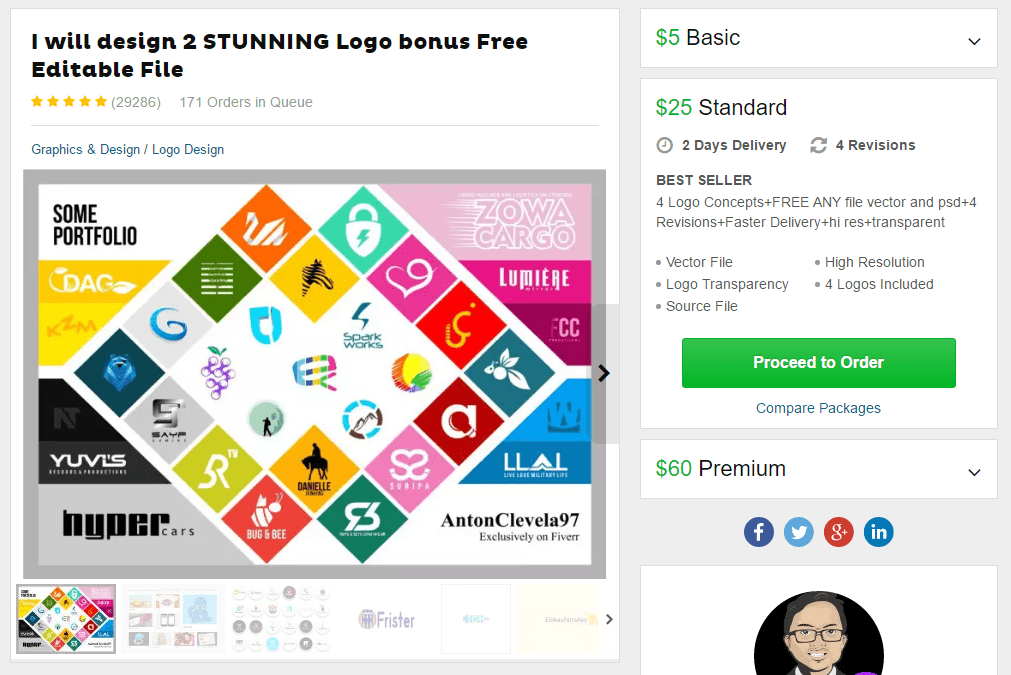
Shop Policies
Lastly, it’s important to make sure your shop policies are properly set up. Your shipping policies, refund policies, privacy policies, payment policies, etc, etc. Etsy will provide some default policies for you but it’s important to review them and adjust them to match your preferences.
You’re welcome to review our Policies and FAQ’s here to get ideas.
https://www.etsy.com/shop/WallDecalSource?ref=hdr_shop_menu#policies
Shop Sections
Now you can setup your shop sections based on the keywords you picked out before, you’ll start to add listings to them in the next step.
About Us Section
Don’t be shy! Create a short bio about yourself, write a little story about your shop or your inspiration.
An about us section is valuable because it allows buyers to relate to you. Some buyers really want to know who they’re buying from so make sure you fill this area out. Check out what others have placed in this area to get some ideas, you can put a story there, pictures of your workshop or anything else. Go crazy!
Anything else
Make sure your shop is 100% complete, policies, about us, announcement, shop sections, banner, logo, shop members and anything else you can think of.
It’s important to complete everything, this will actually have an effect on your search engine rankings, so don’t skip anything!
#6 Start creating items for your shop and listing them.
FINALLY!!! It’s time to actually list some products to SELL!!!
Depending on what you’re selling you’ll probably have to create a few products so that you can take pictures of them and list them for sale.
You should start your shop with at least 10 products and then add new ones on a regular basis. It’s best if you can create products that you can recreate and sell multiple times. This is the best way to build your shop and have consistent sales. If you’re only creating one of a kind items it will take a lot more effort because you’ll have to take new pictures and create a new listing every time you sell an item.
You can take photos for multiple products all at one time, batching tasks together make the listing process a lot easier.
Photos
I highly suggest you use all 10 picture slots, this is going to give you the best chance of selling your item. Take your photos with natural light and make sure they are displayed nicely. If it’s a product that can be modeled like a hat or a necklace then show it off. Use something to show the items scale, if you’re selling a necklace you could lay it next to a quarter so that people could get an idea of the size of it.
Make sure you don’t put multiple products in a photo that could possibly be included. For example, if you’re selling earrings then you shouldn’t use a picture that has a matching necklace in it. Some people may get confused and think the necklace is part of the set. Get creative with your photos, stage them, make it interesting and captivating!
Look at these earrings on a teacup, what a great way to stage them!
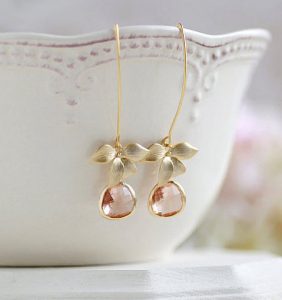
Listing Titles
This is where all those sub keywords come in handy, you can string them all together to build a powerful title for your listing. Listing titles is not a place to get creative, use the keywords that you think people will be searching for to find your items.
The listing titles is the #1 thing that Etsy uses to decided where your listings should appear in the search results, so if you give your listing a cute name like “The Betty Necklace” then no one is likely going to find it.
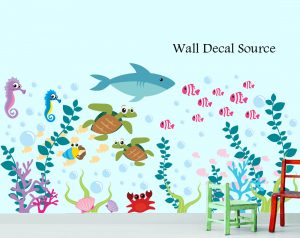
Here is the our title for this listing of ours.
Shark Wall Decal – Ocean Wall Stickers – Underwater Decals – Nautical Decals – Removable Wall Decals – Ocean Decals – Fish Decals
Don’t be afraid to use the same keywords for multiple listings. You can even use very similar keywords on the same listing. You can use whatever you want to separate the keywords in your listing titles, commas, dashes or something else. It really doesn’t matter.
Description
The description is where you should answer all the questions someone could have about your product. Remember a confused mind says no. If someone is unsure about something on your product most of them will simply not buy.
Here’s a few example questions:
What gender is this for?
Can I machine wash this?
What material is this made from?
Is this handmade or factory made?
How long will this last?
What size is this?
How many come in a package?
Can I customize this?
You should also use the description to sell the item, describe how they are going to feel when they have the products in their hands or in their home etc.
For example: This beautiful necklace goes with nearly any outfit! You’re going to look fantastic when you wear this out, people will comment on how gorgeous it is and be up to their ears in jealousy!
LOL that’s a little extreme but you get the point. Coca Cola does a great job selling a feeling in their ads, they don’t talk about the sugar or the taste, they talk about a feeling you may have when you’re enjoying a Coke.

Everything Else
Make sure you fill out all the other details of the listing; who made it, category, quantity, etc, etc. Don’t leave any details unanswered, list your item and you’re on the way to success!
#7 Start driving sales
You should get at least 10 listings published to get your shop started, you shouldn’t focus on this part until then.
Adding new listings
You should continue to add listings on a regular basis, this will show Etsy that you’re a serious seller and that you plan to make your shop a real business. They want to send customers to sellers they know are going to take care of them, so being active on your shop regularly is important.
You should try to add 5 listings or more per week for the first few months if possible.
Running Sales
Because your shop is brand new, you won’t have any reviews that prove you are trustworthy. At this point you should be running the best sales you can possibly afford to get your shop off the ground.
Grand opening sales are a great place to start. Make the sales as good as you can, you can even put a shop announcement up that says something like this.
Welcome to our shop! We are brand new and excited to serve you, please take advantage of our awesome sale and help us get started!
We would appreciate your business and your feedback a lot!
Use coupon code GRANDOPENING to get 50% off everything!
People love to be the first and they love to help people get started. This can help your shop get jumpstarted a lot faster then it would otherwise.
Once Etsy starts to notice you’re making sales they will start to send you more and more traffic. After you get a few sales and reviews you can end the grand opening sale or replace it with a less generous sale and your shop should keep the momentum.
Renewing Listings
Renewing your listings has always been an effective way to grow your shop sales. When you list a new item it costs $.20 and the item will remain active for 4 months on Etsy.
Renewing an item cost $.20 and it starts the 4 month period over. At the bottom of every listing you will see the “Listed On” date, when you renew a listing the “Listed On” date will be reset to today’s date.
Renewing listings usually puts the item back near the top of search results, this is helpful because the closer your listing is to the top of search results the more views it will get and the more sales it will make. 72.92% of the listing on the first page for most Etsy search results are less than 1 week old, so if you want to keep a listing near the top you should renew it more frequently than every 4 months. We usually renew each item about every 2 weeks, if it doesn’t sell then we stop renewing it after about 10 times and let it expire.
Getting your first reviews

Your first reviews are the most important reviews your shop will receive and the more you can get early on the better.
We actually put handwritten thank you notes in our first few orders and nearly all of our early customers left us a review.
Offer your early buyers special thank you coupons and ask or even beg them to leave you some feedback.
Duplicating listings
Duplicating your listings is also another very effective way to get your listings to appear for lots of different keywords. This video explains how this process works.
#8 Keep Pushing Your Shop
I see a lot of people get all the above steps correct but they still make several mistakes that cause them to fail. If you want to learn the 7 mistakes you need to avoid in order to have success on Etsy then register for our free Etsy training class.
Click Here to Register for Our Free Etsy Training Class“
- The 7 mistakes that will destroy your shop EVEN if you do everything else right.
- Our 6-Step New Shop Growth Plan that will make your shop one of the fastest growing new shops on Etsy in 30 days or less.
- The 93-word convo message template that we use on Etsy users to consistently increases our sales every month.
- How you can find and leverage your bestsellers to double their sales every month in 3 easy steps.
- At the end of the webinar we’ll do a Q & A and answer all the questions that we possibly can.
- And so much more…

